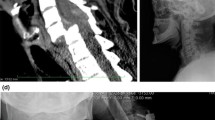Abstract
Aim
Posterior cervical spine fixation has undergone tremendous advancement in recent years. The purpose of this study is to present our experience with the Roy-Camille instrumentation for posterior cervical stabilization after injury in a long-term follow-up.
Patients and methods
From 1985 to 1995, 76 patients with a lower cervical spine traumatic lesion were treated in a single institution by posterior plate stabilization using the Roy-Camille plates (R-C plates). Fifty-four men and 22 women with a mean age of 43.2 years were involved. In 59 patients the injuries were due to a road traffic accident, in 14 cases the fall from a high was responsible, while in two cases the injuries were due to sport activities. There were four bilateral dislocations, nine unilateral dislocations, 56 fracture dislocations, five fracture separations of a lateral mass and two burst fractures. Neurological lesions were present in 65 patients (9 ASIA A, 16 ASIA B, 22 ASIA C, 18 ASIA D and 11 ASIA E). All patients had minimum follow-up of 7 years. Fifty-nine patients were followed up for a mean period of 21 years (14–27 years).
Results
Stability was obtained in all but two cases. Reoperation was done in two cases: in one for the correction of the lost reduction and in a second for the reinsertion of a screw irritating a nerve root. No case in the ASIA A group showed neurological improvement, a fact observed in the other groups.
Conclusions
The R-C plates were used in the last quarter of the last century. This technique showed good short-time results, and we have shown good results in a long-term follow-up as well. The literature referred to this technique was favorable, as far as the biomechanical behavior and also clinical application concern. The question about this plating system abundance still remains unanswered.




Similar content being viewed by others
References
Roy-Camille R, Saillant G, Mazel C (1989) Internal fixation of the unstable cervical spine by a posterior osteosynthesis with plates and screws. In: Sherk HM (ed) The cervical spine. Lippincott, Philadelphia, pp 390–403
Saillant G (1979) Techniques d’osteosynthese du rachis cervical inferieur. In: Roy-Camille R, Barras E (eds) Rachis cervical traumatique non neurologique. 1ères Journées de la Pitié. Masson, Paris, pp 36–41
An HS, Gordin R, Renner K (1991) Anatomic considerations for plate–screw fixation of the cervical spine. Spine (Phila Pa 1976) 16:S548–S551
Anderson PA, Henley MB, Grady MS, Montesano PX, Winn HR (1991) Posterior cervical arthrodesis with AO reconstruction plates and bone graft. Spine (Phila Pa 1976) 16:S72–S79
Magerl F, Grob D, Seemann P (1987) Stable dorsal fusion of the cervical spine (C 2-Th 1) using hook plates. In: Kehr P, Weidner A (eds) Cervical spine I. Springer, Wien, pp 217–281
Bransford RJ, Lee MJ, Reis A (2011) Posterior fixation of the upper cervical spine: contemporary techniques. J Am Acad Orthop Surg 19:63–71
Fehlings MG, Cooper PR, Errico TJ (1994) Posterior plates in the management of cervical instability: long-term results in 44 patients. J Neurosurg 81:341–349
An HS (1995) Internal fixation of the cervical spine: current indications and techniques. J Am Acad Orthop Surg 3:194–206
Stauffer ES, Kelly EG (1977) Fracture-dislocations of the cervical spine. Instability and recurrent deformity following treatment by anterior interbody fusion. J Bone Joint Surg Am 59:45–48
Montesano PX, Jauch E, Jonsson H Jr (1992) Anatomic and biomechanical study of posterior cervical spine plate arthrodesis: an evaluation of two different techniques of screw placement. J Spinal Disord 5:301–305
Grubb MR, Currier BL, Shih JS, Bonin V, Grabowski JJ, Chao EY (1998) Biomechanical evaluation of anterior cervical spine stabilization. Spine (Phila Pa 1976) 23:886–892
Kotani Y, Cunningham BW, Abumi K, McAfee PC (1994) Biomechanical analysis of cervical stabilization systems. An assessment of transpedicular screw fixation in the cervical spine. Spine (Phila Pa 1976) 19:2529–2539
Errico T, Uhl R, Cooper P, Casar R, McHenry T (1992) Pullout strength comparison of two methods of orienting screw insertion in the lateral masses of the bovine cervical spine. J Spinal Disord 5:459–463
Klekamp JW, Ugbo JL, Heller JG, Hutton WC (2000) Cervical transfacet versus lateral mass screws: a biomechanical comparison. J Spinal Disord 13:515–518
Donovan WH, Kopaniky D, Stolzmann E, Carter RE (1987) The neurological and skeletal outcome in patients with closed cervical spinal cord injury. J Neurosurg 66:690–694
Dove J, Hsu LC, Yau AC (1981) Spontaneous cervical spinal fusion. A complication of halo-pelvic traction. Spine (Phila Pa 1976) 6:45–48
Jones EL, Heller JG, Silcox DH, Hutton WC (1997) Cervical pedicle screws versus lateral mass screws. Anatomic feasibility and biomechanical comparison. Spine (Phila Pa 1976) 22:977–982
Barrey C, Mertens P, Jund J, Cotton F, Perrin G (2005) Quantitative anatomic evaluation of cervical lateral mass fixation with a comparison of the Roy-Camille and the Magerl screw techniques. Spine (Phila Pa 1976) 30:E140–E147
Roy-Camille R, Mazel C, Edouard B (1988) Luxations et luxations–fractures. In: Roy-Camille R (ed) Rachis cervical inferieur. Masson, Paris, pp 94–103
Mazel Ch, Roy-Camille R (1991) Utilisation de la plaque en tuile dans les synthèses par plaques postérieures du rachis cervical inférieur. Rachis 3:191–197
Conflict of interest
None.
Author information
Authors and Affiliations
Corresponding author
Rights and permissions
About this article
Cite this article
Korres, D., Nikolaou, V.S., Kaseta, M. et al. Posterior stabilization of cervical spine injuries using the Roy-Camille plates: a long-term follow-up. Eur J Orthop Surg Traumatol 24 (Suppl 1), 125–130 (2014). https://doi.org/10.1007/s00590-013-1376-x
Received:
Accepted:
Published:
Issue Date:
DOI: https://doi.org/10.1007/s00590-013-1376-x




